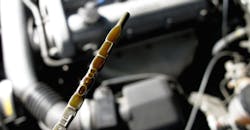Whether on the road or at the shop, lubricants are a critical step in any maintenance program to keep equipment running smooth. But do you know what actually makes up these important lubricants?
Today’s lubricants contain more technology than many people realize. And, by learning what’s inside a product, you can make smarter choices for your equipment and see better, more efficient results. Lubricants — from engine oils to hydraulic fluids — have three main components: the base oil, an additive package and a viscosity modifier.
Part 1: Base oil
When people think about lubricants, they often think of the base oil. Depending on a lubricant’s formulation, the base oil makes up 70 to 90 percent of its overall composition, which makes the quality of the base oil incredibly important.
In the industry, there are five categories of base oil — Group I, Group II, Group III, Group IV, which are known as PAOs, and Group V — each with different quality implications and benefits. The group numbers generally indicate how much wax is present in the formulation after the base oil has been refined. In addition, it’s important to know the difference between conventional, full synthetic, and synthetic blend products:
- Conventional oils are refined, but minimally processed.
- Full synthetic base oils, like those used to formulate, the Cenex® line of Maxtron® products, are not only refined, but also distilled and broken down to their base molecules. These molecules are reshaped to a uniform size, which means they are exceptionally more stable against thermal oxidation compared to conventional oils.
- Synthetic blends are a combination of conventional and full synthetic oils.
Part 2: Additive package
So what makes different types of lubricants, with the same group base oils, have different functions? The answer is the additive package. Products have distinct additive packages based on the functions they need to perform. Additive packages vary, but almost all include:
- A foam inhibitor, to minimize the amount of foam created by the rapid movement of lubricated parts. Although some foam is inevitable, large amounts of foam can be detrimental to equipment as foam is not a sufficient lubricant.
- Detergents to get rid of dirt, soot and particles that, if left untreated, can build up and cause severe engine problems.
- Dispersants to break up debris and keep it suspended so it doesn’t stick to engine surfaces.
- Anti-wear to protect critical moving parts from premature or excessive wear.
- Cold flow improvers to ensure proper oil flow during cold startups.
Part 3: Viscosity modifier
The third and final component of a lubricant is the viscosity modifier. Years ago, you had to change your oil each season to adapt to the temperature change. Without a viscosity modifier, a lubricant that runs thin in the summer, for example, will run thick in the winter. But with a viscosity modifier, a lubricant can behave like a 30 weight when it’s hot, and like a 10 weight when it’s cold, protecting your engine no matter the temperature outside.
Whether on the road or in the field, lubricants are an important necessity for any equipment. When you understand your lubricant, you can choose the best product for your needs. Cenex offers a full line of lubricants designed for CARS, FLEET VEHICLES and FARM EQUIPMENT. For any questions about which oil is right for you, contact your LOCAL CENEX DEALER.
About the Author
Erin Wroge
Erin Wroge is senior director of energy marketing for CHS. Wroge has 13 years of marketing and communications experience.
